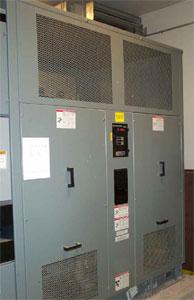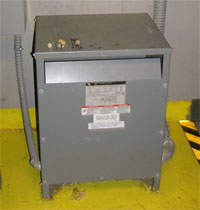The U.S. Department of Energy (DOE) has issued a Final Rule setting minimum efficiency standards for liquid-immersed and medium-voltage, dry-type distribution transformers. The rule goes into effect on January 1, 2010. Thereafter, no distribution transformers not meeting the minimum standards may be sold for use in the U.S. The DOE calculates that the Final Rule will result in considerable energy savings nationwide, and that's undoubtedly correct. But the rule could have gone farther, and many users can reduce their energy costs by pursuing an option the rule left out.TEST
Transformer Types and Uses
Distribution transformers are those that have "a primary voltage of equal to or less than 35 kV, a secondary voltage equal to or less than 600 V, a frequency of 55-65 Hz, and a capacity of 10 kVA to 2500 kVA for liquid-immersed units and 15 kVA to 2500 kVA for dry-type units…" 1 The transformers are either liquid-immersed or dry-type, and dry-type transformers are either medium-voltage or low-voltage depending on whether their primary voltage is greater or lower than 600 V, respectively. The Final Rule addresses only medium-voltage models.
About a million distribution transformers are produced and sold annually in the U.S., and virtually all electric power in the country passes through at least one of them before it's consumed. How will the Final Rule affect the companies that buy and use them?
- Almost all liquid-immersed distribution transformers are bought by utilities to step down line voltages (typically, 4 kV to 34.5 kV) to 277/480 V for their commercial, industrial and institutional customers and 120/240 V for residential accounts. They are covered under the Final Rule, and rightly so, because they operate 24/7/365, and even small improvements in efficiency eventually yield large energy savings.
- Most medium-voltage, dry-type distribution transformers are owned by commercial and industrial companies, government agencies and other large-facility operators, Figure 1. The transformers mainly step utility power (1 to 35 kV primary) down to 480 V or less, three-phase current for motor-driven equipment and for further voltage reduction downstream. Some single-phase transformers are also included here. Facilities may have one or more medium-voltage distribution transformers, and all do fall under the Final Rule.
- Low-voltage, dry-type transformers are also user-owned. They are defined as having a primary voltage of 1 kV or below, and operate downstream from medium-voltage service-entrance units. The transformers are typically installed near load centers to step down 480-V feeder voltage to 208-V and 120-V levels for lighting, three-phase, and single-phase branch circuit plug loads, respectively, Figure 2. Low-voltage distribution transformers are not included in the Final Rule, which is unfortunate. There can be several low-voltage units for each medium-voltage transformer in a facility, and the Rule, as written, ignores additional energy-saving opportunities that may be available to users.
 Figure 1. Typical medium-voltage, dry-type transformer. This one is rated at 750/1000 kVA and steps down the 12.47 kV utility feed to 480-V, 3-phase power for use in motor-driven equipment and for step-down to lower voltages downstream in the facility (a university).
Figure 1. Typical medium-voltage, dry-type transformer. This one is rated at 750/1000 kVA and steps down the 12.47 kV utility feed to 480-V, 3-phase power for use in motor-driven equipment and for step-down to lower voltages downstream in the facility (a university). Figure 2. A typical dry-type, low-voltage distribution transformer. The transformer shown here is a high-efficiency, 100% copper-wound model rated at 15 kVA, 480-208Y/120-V for branch circuit loads.
Figure 2. A typical dry-type, low-voltage distribution transformer. The transformer shown here is a high-efficiency, 100% copper-wound model rated at 15 kVA, 480-208Y/120-V for branch circuit loads.Low-Voltage Transformers Removed
The DOE did include low-voltage transformers in early drafts of the Rule but removed them before publishing the Advanced Notice of Proposed Rulemaking because, by then, they had already been addressed under the Energy Policy Act of 2005. Mandated minimum efficiencies are listed in Table 4-2 of the National Electrical Manufacturers Association (NEMA) TP-1-2002, '' Guide for Determining Energy Efficiency for Distribution Transformers''. This is the well-known "TP-1" standard.
Higher Efficiency Due to Lower Losses
TP-1 transformers are several percentage points more efficient than lower-cost, standard-grade (150°C-rise) transformers. By contrast, the Final Rule for medium-voltage distribution transformers calls for, on average, efficiencies that are between about 0.2 and 0.3 percentage-points higher than TP-1 levels, measured at 50% loading. The Final Rule raises the efficiency bar very little above TP-1, but the Rule's real value to national energy conservation is that it forbids the installation of standard-grade transformers, which are several percentage points less efficient.
Efficiency standards for low-voltage TP-1 transformers are set at 35% of full load. Efficiency peaks at, and slightly above this loading level, Figure 3. It is important to understand that TP-1 rated transformers gain their high efficiency because they contain better-quality core steels. The steels reduce core losses, which are present whenever a transformer is energized, loaded or not. Core losses remain relatively constant with the degree of loading.
 Figure 3. Effect of transformer loading on efficiency for standard-grade, 80°C-rise, and TP-1 transformers. Efficiency peaks at 35% loading for standard and TP-1 models, but 80°C-rise units excel when loading exceeds 65% of rated capacity.
Figure 3. Effect of transformer loading on efficiency for standard-grade, 80°C-rise, and TP-1 transformers. Efficiency peaks at 35% loading for standard and TP-1 models, but 80°C-rise units excel when loading exceeds 65% of rated capacity. Natural Resources Canada data.
Winding losses, on the other hand, vary roughly with the square of the winding current (I²R) and therefore increase with the degree of loading. Winding losses are reduced by using lower-resistance copper winding conductors, preferably in the entire transformer but occasionally (to reduce cost) only on the secondary side. Copper used in low-temperature-rise (80°C and 115°C) transformers keeps losses low under high degrees of loading, Figure 4. But, another advantage of copper windings is that they generally reduce the amount of core steel needed, thus simultaneously reducing the core losses.
 Figure 4. Effect of degree of loading on total losses in standard, 80°C-rise and TP-1 transformers. The low total losses seen in 80°-rise when loaded above 65% of capacity explains their superior efficiency in this range.
Figure 4. Effect of degree of loading on total losses in standard, 80°C-rise and TP-1 transformers. The low total losses seen in 80°-rise when loaded above 65% of capacity explains their superior efficiency in this range. Natural Resources Canada data.
Canadian Study Spotlights Potential Savings
A recent study 2 of dry-type, low-voltage distribution transformers conducted for Natural Resources Canada compared the efficiencies of standard (150°C rise) and low-temperature-rise transformers with those of TP-1 rated models as a function of loading. The results shown in Figure 3 , illustrate how efficiencies change as loading increases. This is important information because it can help users (a) select the most efficient transformer type, and (b) load it correctly for lowest-cost operation.
For example:
- For loading up to about 45% of rated capacity, Figure 3 indicates that TP-1 transformers are clearly more efficient than either standard or low-temperature-rise models. TP-1 transformers are more expensive to buy than standard models, but they reduce operating costs over their service lives.
- For loading between roughly 45% and 65% of rated capacity, differences in efficiencies among the three types are modest. Since most transformers tend to be oversized (and therefore lightly loaded) TP-1 transformers are probably good choices here, as well.
- However, above about 50%-60% loading, the efficiencies of both standard and TP-1 rated models progressively fall below that of 80°C-rise transformers, Figure 3. The difference reaches nearly two percentage points above about 80% loading. It is in this range that 80°C-rise models are the best long-term investment.
Transformers are inherently efficient machines, and two percentage points constitute a huge efficiency premium, one that can yield large operating-cost savings over time. Consider the 40 kVA-rated, low-voltage model shown in Figure 2, in which a two-point improvement amounts to about 40 X 8760 X 0.02 = 7000 kWh per year energy reduction assuming 24/7 operation at near-full capacity. That represents nearly $500 in annual operating costs where electricity costs $0.07/kWh, the U.S. national average. For a 600-kVa transformer the annual savings would exceed $7300 under those conditions.
Oversizing: Not Always a Good Idea
Oversizing transformers is common. The Canadian study analyzed 86 dry-type low-voltage transformers in 43 commercial, industrial and institutional buildings with 480-V service (in New England) and found that RMS-average transformer loads varied from 14.1% to 17.6%, averaging only 15.9%. Maybe the owners anticipated adding loads in the future. Maybe they believed that lightly loaded transformers would last longer. The building developer might have thought it would be cheaper to oversize than to retrofit later on. All of that may be true, but does oversizing really save money when it comes to low-voltage distribution transformers?
Well, the facts say that it doesn't. The data show that installing smaller and more efficient 80°C-rise transformers and loading them to more than 80% of capacity maximizes efficiency and minimizes long-term, life-cycle operating costs. The admittedly more expensive low-temperature-rise transformers pay back their cost premium in a couple of years―and sooner where utility rates are high (are yours?)―after which the savings continue to accumulate for the life of the transformer. And speaking of reliability, remember that low-temperature-rise transformers should tend to outlast other types because they run cooler.
It's the same old familiar story: Buyers can pay a little more up front for a better transformer and save a lot more money down the road, or they can buy an oversized, lowest-first-cost transformer standard transformer and pay higher utility bills for as long as it lasts. High-efficiency, low-temperature-rise transformers will save energy and money in the long term when they're loaded correctly, and they'll keep on saving money longer.
Reducing energy costs with more efficient transformers is a no-brainer once you have the facts. You have the facts, now go save some money.
Read the full text of the Department of Energy Regulations from the Federal Register [PDF-322KB].
Footnotes
-
 U.S. Department of Energy. [PDF-322KB]
U.S. Department of Energy. [PDF-322KB] -
 Natural Resources Canada, "Study: Metered Load Factors for Low-Voltage, Dry-type Transformers in Commercial, Industrial and Public Buildings", 2006.
Natural Resources Canada, "Study: Metered Load Factors for Low-Voltage, Dry-type Transformers in Commercial, Industrial and Public Buildings", 2006.
